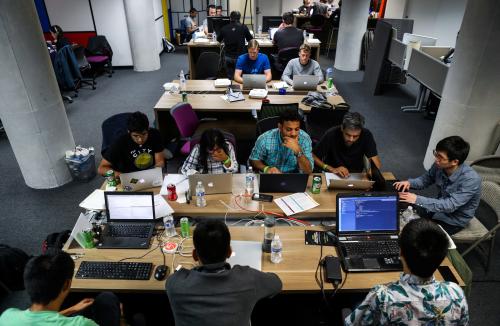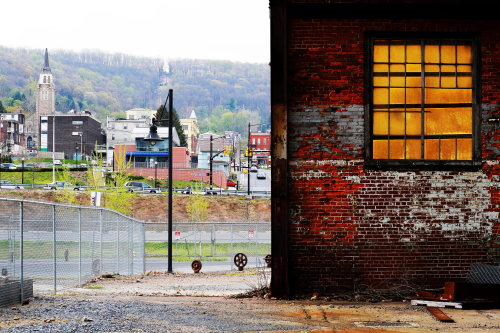How can the American Heartland raise the quality of its economic growth for its region and the nation? This was a core issue raised by the recent State of the Heartland: Factbook 2018 report, and the question continues to be raised in many articles.
No doubt it’s a tough question, but one promising strategy is clear, compelling, and ready to go: It involves better university engagement in commercializing research and supporting local businesses.
Research universities fulfill their mission by creating new knowledge and disseminating it. Universities achieve this by transferring human capital they develop and translating research to existing firms or startups via the commercialization process. Heartland universities hold their own in attracting federal research dollars, but more emphasis should be placed on securing industry-sponsored research and supporting faculty, staff and students in commercializing their intellectual property (IP).
In the 21st century, public and private research universities are the seed capital for creating knowledge that fosters scientific and technology-based economic development.
More universities need to think a bit more like Thomas Edison: He relied on a simple philosophy to guide research that led to world-changing inventions such as the first practical light bulb, the motion picture camera and an early version of the phonograph. “Anything that won’t sell, I don’t want to invent,” said Edison. “Its sale is proof of utility, and utility is success.” This might be extreme for the nation’s public research universities, but instilling this mindset at universities throughout the Heartland could promote higher levels of business formation, successful scale-ups, and job creation.
This strategy rings true because research universities that engage in commercializing the IP they create form a critical component of a regional innovation ecosystem. Almost all dynamic, high-tech clusters around the country are anchored by leading research universities. In the 21st century, public and private research universities are the seed capital for creating knowledge that fosters scientific and technology-based economic development.
What’s more, the benefits of such commercial activity are often reaped locally and can redound to the university’s benefit. Extensive literature validates the degree of locally derived university IP, and confirms that much of the company growth that stems from university enterprise is in close proximity to research universities. At the same time, industry experts can provide their research findings to universities, which leads to new solutions and insights.
A quick cataloguing of the region’s assets suggests there is work to be done to increase the commercialization of research and therefore contribute to economic growth, but the 19-state Heartland region is already at a decent starting point.
In a study that I led for the Milken Institute on which American research universities were best at technology transfer through licensing and startup activity, there weren’t any top 25 universities in 15 out of 19 Heartland states.

Ranked 32nd, the University of Nebraska had the best performance among universities in these 15 states, followed by the University of Missouri at 34th and the University of Wisconsin-Madison at 35th. With that said, other states contain nationally significant crown jewels. Purdue had the highest tech transfer rating in the Heartland at 12th, and was first among public universities without a medical school, followed by the University of Minnesota at 14th, the University of Michigan at 16th and the University of Illinois Chicago-Urbana at 18th. In total, the 19 Heartland states had 25 universities in the top 100 in the nation.
I believe that public universities in the Heartland can learn a lot from best practices at Purdue, Minnesota, Michigan, and Illinois by providing greater incentives and support for faculty to participate in entrepreneurial activities. Purdue provides a good case study. Established in 2013, the Purdue Foundry added a commercial accelerator to the mix of entrepreneurial support. Part of Purdue Foundry, Purdue Ventures established three venture capital funds with assets ranging from $2 million to $12 million to enhance access to early-stage funding. It also provided social network assistance in connecting talent and mentors among Purdue alumni with skills that align with a particular startup. Purdue also concluded that departments, schools, and labs needed to have additional discretion to include commercialization metrics among the set of impact criteria for tenure decisions.
If Heartland universities made patenting, licensing, or startup activity key factors in faculty tenure decisions or placed more weight on them, it would send a strong signal to young researchers that they support entrepreneurial activities.
If Heartland universities made patenting, licensing, or startup activity key factors in faculty tenure decisions or placed more weight on them, it would send a strong signal to young researchers that they support entrepreneurial activities. Further, public universities in the Heartland could increase the IP ownership rates provided to academic inventors. By providing greater financial incentives for these activities, states and universities could nudge more of their researchers in the production direction Edison indicated.
When one examines the numerous interactions, it becomes apparent that even local economic development officials fail to comprehend the full contributions of research universities and vast potential for further engagement. Communities must do a better job of supporting and exploiting the research universities in their midst. Not enough communities fully comprehend the importance of entrepreneurship in retaining a higher share of the graduates created in their own backyard. Many Heartland research universities can improve upon their participation in the local economy and spur stronger growth for the nation as well.
Ross DeVol is a Walton Fellow at the Walton Family Foundation (WFF) and a co-author of the State of the Heartland: Factbook 2018. DeVol will soon lead the new Core Economic Institute whose mission will be to improve economic performance in the center of the United States.







Commentary
Catalyzing economic growth in the Heartland starts with research universities
December 20, 2018